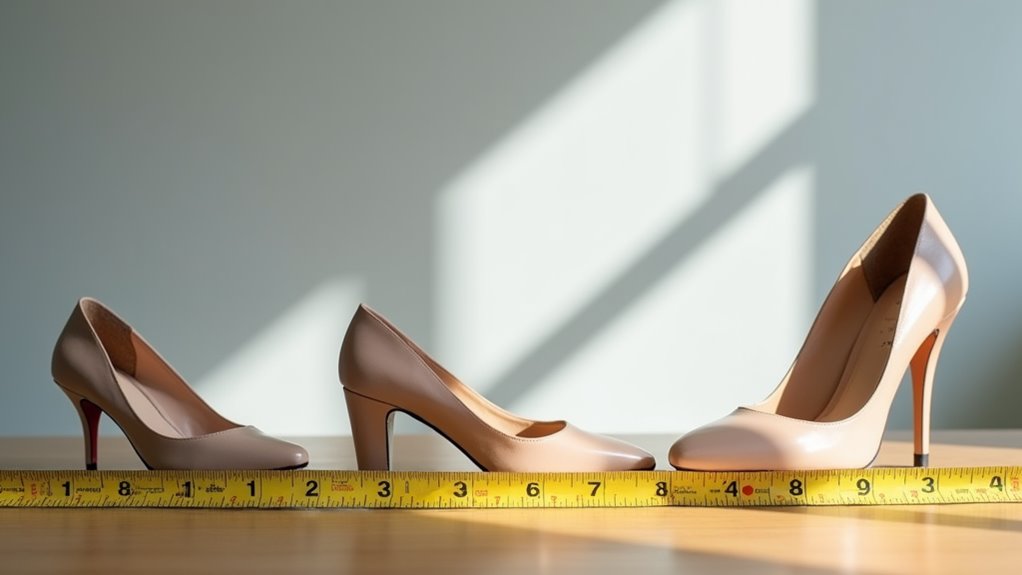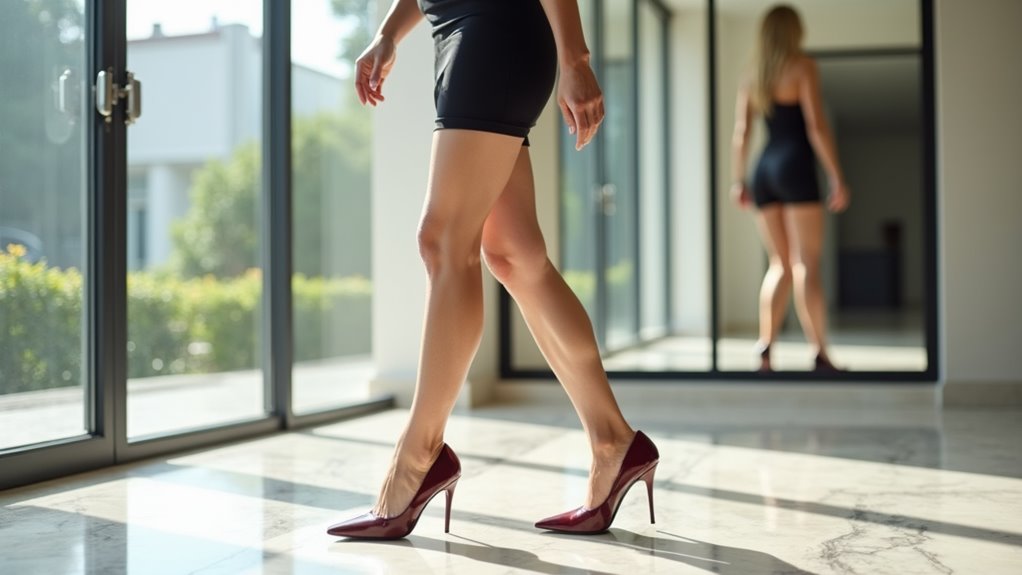There may be products. Products are independently selected by our editors. We may earn an affiliate commission from the links with no charge to you, example: as Amazon Affiliate.
We’ll reduce elevated footwear-induced back pain through three key biomechanical strategies. First, we recommend selecting heels of 1 inch or lower, as this height maintains neutral spinal alignment while minimizing lumbar lordosis. Second, we’ll implement targeted stretching routines focusing on the gastrocnemius-soleus complex and hip flexors to counteract muscle tension patterns. Third, we’ll optimize walking mechanics by engaging core stabilizers and adopting shorter stride lengths with proper foot rotation. These evidence-based techniques represent the foundation of a comprehensive approach to spinal health for elevated footwear wearers, with additional strategies to enhance their effectiveness.
Key Takeaways
- Choose heels no higher than 1 inch to maintain neutral spine alignment and minimize pressure on your back.
- Practice regular calf and hip flexor stretches to prevent muscle tightness that contributes to back strain.
- Engage core muscles while walking and take shorter strides to maintain proper posture and reduce spinal stress.
- Invest in shoes with cushioning technology and supportive insoles to redistribute pressure and enhance comfort.
- Perform strengthening exercises for glutes and core muscles to improve stability and prevent back pain.
Proper Heel Height Selection

Selecting appropriate heel height stands as the cornerstone of preventing back-related complications in elevated footwear. We’ve found that proper heel height selection directly impacts spinal alignment, with heels exceeding 1 inch significantly increasing pressure on the spine. When we examine the biomechanics, higher heels force the lumbar region into excessive lordosis, creating unnecessary strain on lower back muscles and joints.
We recommend maintaining heel heights at or below 1 inch to preserve neutral spine positioning. Research demonstrates that regular high heels wearers experience more negative effects on their musculoskeletal system, particularly affecting the natural curvature of the spine. For those who must wear elevated footwear, we strongly advise incorporating cushioned insoles to help distribute pressure more evenly and enhance comfort during wear. Consider investing in comfort technology heels that are specifically engineered to provide better support and minimize back strain.
Essential Stretching Techniques
While heel height selection helps prevent back pain, proper stretching techniques form the foundation of muscle health when wearing elevated footwear. We’ll focus on targeted exercises that maintain spinal alignment and provide support for back pain caused by prolonged heel wear.
Let’s start with calf and soleus stretches against a wall, holding for 30-60 seconds to alleviate tightness in these commonly affected muscle groups. We’ll complement this with the hip flexor stretch, performed in a lunge position while engaging the glutes and maintaining pelvic tilt to reduce lower back strain. For immediate relief, we recommend the tennis ball release technique, applying focused pressure to overactive muscles for 1-2 minutes.
To address muscular imbalances, we’ll strengthen glutes through hip raises, performing 2-3 sets of 10-15 repetitions while maintaining neutral spine position. Finally, we’ll incorporate core strengthening exercises, specifically the dead bug movement, which helps stabilize the spine during heel wear. When executing these movements, we’re focusing on precise form and controlled motion to maximize their therapeutic benefits and prevent further strain. For optimal results, combine these exercises with foot care products specifically designed to support proper alignment and comfort.
Smart Walking Strategies

To move efficiently in elevated footwear, we must focus on biomechanical adaptations that optimize weight distribution and minimize strain through the kinetic chain. Smart walking strategies begin with maintaining proper posture through core muscle engagement, which stabilizes our spine during locomotion. We’ll reduce stress on knees and lower extremities by adopting shorter stride lengths with slight external foot rotation.
| Movement Component | Biomechanical Adaptation |
|---|---|
| Stride Length | Shorter steps with controlled placement |
| Foot Position | Slightly externally rotated |
| Weight Transfer | Dynamic shifting between feet |
| Postural Control | Active core muscle engagement |
| Movement Pattern | Fluid, continuous motion |
When we’re required to stand, we’ll implement weight-shifting techniques to reduce muscle tension and promote circulation. Let’s transition to supportive shoes with adequate cushioning and support whenever possible, particularly during extended walking periods. This strategy maintains flexibility while preventing overuse of compensatory muscles. By integrating these biomechanical principles into our gait pattern, we’re creating an optimal foundation for sustained comfort and reduced risk of musculoskeletal strain. Wellness style shoes can provide essential comfort features that support proper biomechanics during daily activities.
Conclusion
By implementing these biomechanical strategies, we’re significantly reducing the risk of lordosis and intervertebral disc compression associated with elevated footwear. But isn’t our spinal health worth the effort of proper heel height selection, targeted gastrocnemius-soleus complex stretching, and optimized gait mechanics? Through consistent application of these evidence-based techniques, we can maintain our desired aesthetics while protecting our thoracolumbar and sacral regions from unnecessary strain.

